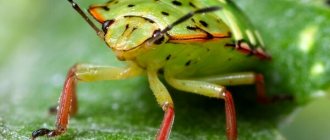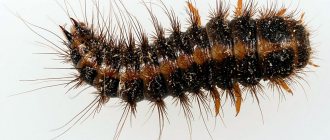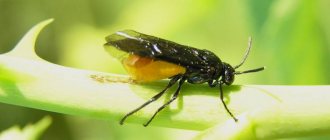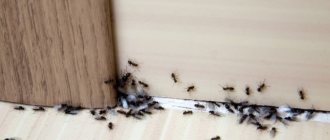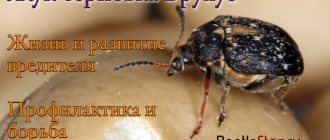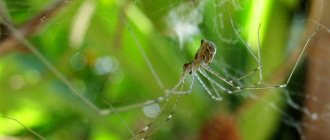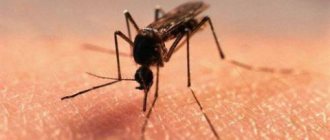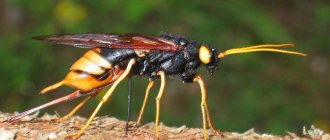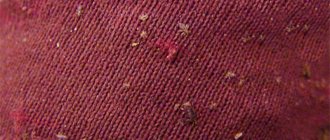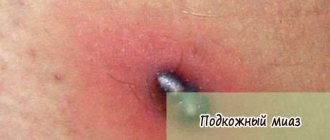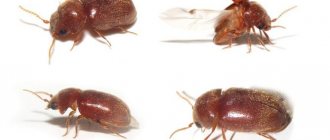Home is the place where a person feels most safe from any threats. However, it happens that unexpected guests in the form of parasitic insects enter your home. Therefore, the discovery of a bean weevil in the living room naturally causes a feeling of discomfort, fear, horror and disgust for many. However, it is necessary to find out the reason for the sudden appearance of bugs in the house and effectively get rid of them.
What does bean weevil look like and what does it eat?
The bean weevil is a small beetle from the caryopsis family (close relatives include the pea weevil and the four-spotted weevil). The brownish, oval-shaped body is covered with copper-colored hairs. The insect has a miniature size of 2-5 mm, so it is difficult to study it in detail without a magnifying glass. If you look at what a bean weevil looks like in the photo, you will notice that the beetle has short elytra covered with gray spots. The hind legs are equipped with sharp teeth.
Bean grain
Interesting!
Insects are very thermophilic and low temperatures are destructive for adults and offspring. At a temperature of 0°C, larvae die after 30 days, adult beetles die after 15 days. At temperatures below 12 °C, the vital activity of the bean grain stops instantly.
Pests overwinter in storage inside grain or in field conditions under plant debris. Awakening occurs in the spring, when the ambient temperature reaches 12-15 °C. The bean grain has extraordinary flight qualities. In search of food supply, it is able to cover a distance of up to 3 km.
Before the beans ripen, insects feed on the leaves of legumes and pollen. In the absence of food, weevils can survive without food for up to 3 months. A massive invasion of pests on bean plantations is observed after the completion of the flowering phase.
Maliciousness
The harmfulness of the bean weevil lies in its rapid reproduction and massive destruction of the crop. Moreover, even in the fields, until the crop is ripe, beetles are able to feed on various parts of legume plants:
- flower petals;
- pollen;
- vegetative organs.
In storage, grains at a favorable temperature can leave only dust from the harvest.
The second important harmful factor is the omnivorous nature of the grain relative to legumes. Therefore, by introducing a pest into a warehouse with one crop, you will most likely give it access to related grains.
Peculiarities of bean seed propagation
Under natural conditions, bean grain propagation occurs during fruit ripening. The female gnaws a hole in the seam of the bean and lays 15-20 white oblong eggs in it. The length of the embryo does not exceed 0.2 mm. The fertility of one female varies from 60 to 200 eggs. The weevil beetle is quite fastidious and its reproduction is possible under appropriate conditions:
- optimal humidity 60-70%;
- ambient temperature is 15-30 °C, at higher temperatures the eggs die;
- availability of nutritional base. Bean grain
In the warm season, embryo development lasts 7-14 days, at lower temperatures 35-40 days. The hatched bean kernel larvae penetrate deep into the bean and then into the grain itself. Newborns have 3 pairs of legs, are distinguished by mobility and the presence of bristles. Several dozen larvae can simultaneously coexist in one bean seed; they eat the contents of the bean and gnaw tunnels in it. The larval maturation stage lasts 3 weeks and ends with pupation.
The young beetle easily gnaws a hole in the bean and leaves it. The full development cycle of the weevil ends in September and October, and most often the larvae enter the storage with the harvest.
Important!
In field conditions, the female gives 2 generations, in the southern regions 3-4. In heated rooms, under favorable conditions, insects breed year-round.
How not to stay on beans: methods of combating weevil
Contrary to their name, grains have nothing to do with wheat, rye and other crops. These pests are enemies of the legume family. Taking into account taste preferences, grains are divided into several types; in Russia, two are especially common: pea and bean. These pests can damage not only plantings, but also the harvested crop: beetles continue to actively multiply in storage facilities, damaging healthy grains.
Content
Description and types of pest
There are more than 1,000 species in nature, about 90 are found in Russia. However, not all weevils are classified as agricultural pests; many prefer to settle on wild plants. Despite the name, weevils have nothing to do with cereals; they prefer legumes, umbelliferous, and bindweed species.
Depending on the species, the size of adult grains varies from 1 to 22 mm. The body is covered with small hairs that form blurry spots. The color of the elytra is light gray, brown, brownish, the body is usually black. The larvae are thick, legless, and white.
Insects are thermophilic, active only in bright sunlight. The larvae develop inside grains (beans, beans, peas).
Pea: features
This type of beetle prefers to parasitize peas, occasionally moving to other legumes, mainly wild ones. You will not find it on beans, legumes and other cultivated representatives of the family.
The pea weevil is very small, the length of an adult insect does not exceed 5 mm. Beetle activity begins in the spring. At first they feed on the pollen of early weeds from the legume family, but with the beginning of pea flowering they move to the plantings. When the pods appear, the females lay a small, transparent white egg in each.
The larvae develop as the pea grows. When the peas ripen, the grown caterpillar penetrates one of them, gnawing a small cave. Here it completes its development, feeding on the pulp of the pea. There the larva pupates, turning into a beetle. After harvesting, infected grains end up in warehouses and barns, where insects overwinter.
Beans: main differences
The bean weevil is considered more dangerous than the pea weevil: it threatens several types of legumes at once.
The risk zone includes:
The adult insect is smaller in size than the previous species - no more than 4 mm in length. The upper wings are dark brown, with longitudinal light spots. The insect develops in the same way as the pea weepsilon, but the fertility of the bean weevil is much higher. The female lays up to 20 eggs in each bean, and during the season their number reaches 100.
Small larvae can parasitize one pea or infect several at once. At the same time, adult beetles that ended up in storage along with the collected pods can continue to reproduce. The cycle of generational change does not stop; as a result, by spring the entire stock of beans, peas or lentils may be infected.
What is the danger of their appearance?
If infected beans are placed in a general storage, by spring you can lose the entire supply: overwintering beetles will continue to lay eggs, and developing larvae will eat the beans from the inside.
The taste of damaged peas or beans deteriorates. Eating peas infected with larvae is simply dangerous: traces of the life activity of the caterpillars remain inside. It is also not worth sowing such material: the germination rate of infected seeds is low, and there is a risk of introducing pests into the soil and provoking a new wave of infections.
Prevention measures
When fighting weevil, special attention is paid to preventive measures. It is necessary to carefully select planting material, giving preference to early ripening varieties. They manage to bloom and form pods before the maximum activity of the weevil.
It is important to buy only proven planting material. The infected one has low germination rate, and there is a high risk of introducing insects into the field or garden.
The presence of larvae is indicated by small dark holes on beans and beans. Preplanting seed preparation with a bio-insecticide will help reduce the risk of infection.
An important point is the storage of the harvested crop. In industrial conditions, regular professional treatment of barns and other storage facilities is necessary: cleaning, drying, disinfection.
At home, beans, peas and beans should be stored in tightly closed glass or metal containers. Storing legumes at a low temperature, for example, on a glazed balcony, will help prevent the proliferation of grains.
After harvesting, you need to remove tops, leaves and other debris as quickly as possible. It can become a shelter for surviving beetles, which become more active with the first days of spring. Plowing the soil in the fall and deep harrowing in the spring will help reduce the risk of infection. It is important to get rid of weeds and wild grasses in a timely manner: they serve as food for pests before cultivated legumes begin to bloom. Representatives of the same plant family pose a particular risk: meadow chin and acacia.
How to fight
Pest control can be divided into several stages:
The gardener's task is to prevent the females from laying eggs in the pods. If this happens, you can act on the larvae, which remain on the surface of the pods for some time after hatching. Once the peas get inside, they become invulnerable until they get out.
Folk recipes
Traditional methods are suitable for combating weevil in small private farms. Their effectiveness varies; measures to prepare seed material are especially helpful. To combat large colonies of beetles, it is recommended to use insecticides.
hood for a swimming pool in a private house
The following methods are suitable for treating seeds before sowing:
If the grains are intended for food, they should not be sprayed with pesticides. Preventative freezing or heating in the oven at a temperature of about 60 degrees is suitable.
In industrial conditions, peas or beans are sprayed with chemicals or fumigated before sowing.
Expert opinion Stefania Bogdanovna Mityuk Treatment of plantings with various decoctions and infusions based on herbs, tops, onion peels or soap are weakly effective against weevil. For spraying, it is better to use safe and low-toxic bio-insecticides.
Bio-preparations
Products based on fungi or bacterial strains. They are characterized by low toxicity and are safe for people, pets, birds and bees. Can be used for processing planting material and spraying throughout the life of plants. The last treatment is carried out no later than 3 days before harvesting.
What damage do beetles cause?
The beetles do not attack people or bite, but they cause significant harm to humans. Infection of plants leads to a decrease in yield. The bean weevil begins to harm plants even at the stage of their growth, damaging early crops. There have been cases where the bean yield was reduced by 70%. In addition to beans, insects are not averse to eating chickpeas, soybeans, and peas. The photo shows beans damaged by beetles.
Harm from grain
Important!
The larvae eat away nutrients from the grains and fill them with their waste products, which makes the beans unsuitable for sowing and consumption. The entry of infected beans into storage jeopardizes the safety of the entire crop.
Prevention
If there is a bean weevil in your summer cottage, it is better to harvest the crop before the beans begin to crack.
Aktara is suitable for processing grains from beans
As a preventative measure to combat this pest, you can spray with appropriate preparations (Aktara, etc.).
Spraying should be done before the beans begin to bloom, or at the very beginning of flowering. Spraying is carried out once, following the instructions on the product.
By applying simple rules, you can get and maintain an excellent harvest of beans in your summer cottage!
Up
Rate the article!
Votes: 1 Average rating: 5
About the author: Nikolay Golubev Experienced gardener with 20 years of experience
- Related Posts
- How to get rid of slugs and snails in the country: ten best ways
- Medvedka: photo and description, how to fight
- Ants on apple and pear trees: what to do and how to get rid of them
« Previous entry
Common Pest Types
The small beetle, which was infested by other cereals brought from the store, penetrates into cracks and corners, latches and poorly closed containers with cereals. It mercilessly eats reserves, leaving behind traces of vital activity. It is very difficult to get rid of them, because if there are acceptable conditions for their life, they actively reproduce. Their favorite delicacy is buckwheat, rice, semolina, millet, and dried fruits. The appearance of bugs in the cereal causes it to become lumpy; such a product should not be eaten. Allergies, diarrhea, toxic manifestations - this is a list of possible troubles. To remove these insects, every effort should be made.
The red flour beetle grows in places where there is a large accumulation of cereals. Mills, bakeries, feed mills - this is a list of its most common habitats. If food is heavily stale and shows signs of rotting, this is favorable soil for insects to breed. The appearance of bugs in the croup is indicated by characteristic traces: the clumping of particles into lumps, excrement and larvae.
The bread grinder is distinguished by its high fertility and vitality, and breeding this insect will not be easy at all. Tiny elongated bugs, 1.8–3.5 mm long, are brownish in color. They often crawl out onto window sills and die there. They damage cereals, tea, coffee, grain, flour products, and also eat crackers, nuts, and herbs. It is difficult to get rid of these insects: the difficulty lies in the fact that they practically do not come out of their hiding places. The visible appearance indicates excessive reproduction of bugs in cereals and their high density.
Attention! If you eat unprocessed foods affected by the bread borer, your body can be seriously damaged.
Development cycle and appearance
Bean weevils are a small insect about 5 mm long, dark brown in color, whose oval body is completely covered with small golden hairs. The dark elytra of individuals do not completely cover the abdomen and have light spots located longitudinally on the surface.
The hind limbs of parasites are equipped with sharp teeth. The beetle eggs are milky, oval, maximum size – 0.7 mm. The larvae are crescent-shaped, dense, up to 4 mm in size.
For successful reproduction, grains require the presence of the necessary nutrient medium - grain fields or warehouses with a legume harvest. A comfortable temperature for individuals ranges from 19 to 29º C, and humidity should not be lower than 75%.
If the necessary conditions are met, parasites can continue to reproduce all year round. In open ground, as a rule, 2 generations of insects develop, and if the ambient temperature is too low, they enter diapause.
Some time after mating, the females gnaw holes in the surface of the beans and lay eggs in the holes made - there can be up to 20 eggs per plant. Females are quite fertile and can lay about 200 eggs per month.
After a month and a half, legless bristly larvae hatch, the development of which occurs in 2-3 weeks, and the full development cycle of the parasites is about 107 days.
For the winter, heat-loving beetles fly into storage, but at fairly comfortable winter temperatures they remain to wait out the cold season among the remains of fallen leaves.
Beetles eat all parts of bean plants, including petals, foliage, flowers and pollen, and also use them for reproduction and breeding. In this case, the yield can be reduced by up to 60%, so it is necessary to apply competent control methods in a timely manner.
How to store beans for the winter?
Green beans are canned and frozen, but grain beans are stored differently, since special conditions must be created for them. The optimal environment for storing this product is a temperature of up to 10 ° C and a humidity of less than 50%. With such indicators, the bugs do not start.
Where and in what should beans be stored?
It is best to pour the peeled grains into fabric bags or glass jars with tight lids (metal or glass). Plastic lids will allow air to pass through. For prevention, the bags are soaked in a solution of table salt and completely dried.
Store only in a cool place (refrigerator, balcony or basement). Optimal air humidity is 50%.
In a warm room, bean grains germinate. It is not recommended to eat sprouts.
How to prepare for storage?
The collected pods are pre-dried. They are laid out on tables in the yard, collected in bunches and hung on the veranda. When the pods become completely dry and the flaps begin to open slightly, it’s time to start shelling.
Sometimes bean grains are heated before planting. The temperature in the oven is not lower than 90 degrees.
Treatment of legumes against pea codling moth
As can be seen in the photo, this pest of legumes is a dark gray butterfly with a wingspan of 11-16 mm. Its hind wings are brownish with a grayish tint along the edge. The egg is 0.7-0.8 mm in size, flattened, oval, white. The caterpillar is 12-13 mm long, green and white. The pupa is 6-8 mm in size, brown, in an oval cocoon. The pest damages peas and lentils.
Overwintering of caterpillars that have completed their development takes place in the soil, at a depth of 3-5 cm, in dense silky cocoons with glued soil particles. After wintering, the caterpillars leave cocoons and rise to the upper layers of the soil, where they begin to weave new cocoons, in which they pupate in April. Pupal development occurs within 11-18 days. On peas, butterflies appear during the budding period, and the beginning of the mass emergence coincides with the flowering of the plants. The flight continues in the second half of June - July.
Females require additional nutrition, so they begin to lay eggs only after 5-13 days, placing them on the underside of leaves, stipules, flower calyxes, and sometimes on stems, pedicels and petioles. After rebirth, the caterpillars gnaw holes in the valve of the young bean and penetrate inside through it. First, they make holes in the walls of the bean, then feed on the contents of the cotyledons. Each caterpillar is capable of destroying up to four grains. The development of the caterpillar occurs in one bean. When the grain ripens, the caterpillars finish feeding, gnaw a hole in the bean valve, through which they emerge and move into the soil to form a hibernating cocoon.
To protect plants from the pea codling moth, it is necessary to timely harvest and thresh grain legumes. When treating peas for pests, it is recommended to spray the plants with a decoction of wormwood, tansy and capsicum. To prepare it, you need to pour 200 g of crushed wormwood herb, 100 g of dry crushed tansy herb and 600 g of finely chopped hot peppers into 10 liters of water, boil for 45 minutes, cool, strain. Spraying is carried out in the evening 1-2 times a week. The procedure should be stopped 2 weeks before harvest.
How to fight?
Housewives often don’t know what to do with bugs in beans. Care will protect you from serious crop losses. Legumes need to be sorted often. If the bugs have just appeared and have not yet had time to spoil many grains, cold or hot air treatment will help. Severely affected grains are immediately discarded. The rest of the beans are placed in the freezer or oven for a while.
When exposed to extremely low or high temperatures, the larvae will not survive.
Small household tricks can also help protect legumes. For example, grains do not tolerate strong odors, so it is useful to put garlic cloves in their husks in bags of beans. In the room where legumes are stored, cloves, bay leaves or nutmeg are often placed.
See also
What is a bean - a vegetable or not, what does the plant look like, description and family Read
Important! Bean storage containers are periodically sanitized. This is an effective preventive measure.
How do bugs get into the house?
Since grains cannot ignore grains and legumes, they somehow end up in packaged foods - either as adults or simply lay eggs in them. When contaminated food enters a living space as a TV dinner or as a treat for guests, the insects present in it move into the room.
How to prepare for storage?
Since the bean beetle penetrates the beans at the stage of their ripening, before storing the harvested crop, it must be prepared. Before laying, the beans should be sorted and dried. To do this, they need to be placed in an oven preheated to 80-90 degrees for 5 minutes. After such heat treatment, the grains lose their ability to germinate, so such beans must be eaten. Many gardeners claim that in order to ensure a longer shelf life of beans, they should be separated from the pods.
Planting beans correctly
Preparation for planting always begins with the soil, it is dug up and loosened. The seeds are soaked in water the night before planting to swell. And in order to protect the future harvest from diseases and pests, the seeds are dipped in a solution of boric acid (1 gram of boric acid per 5 liters of water) for literally 5-7 minutes.
Beans require 12 hours of sunlight to properly ripen and grow outdoors. Therefore, choose a place that is well lit, without shadows and protected from wind and moisture. The soil should not be clayey or overloaded with nitrogen. Even an area with depleted soil is suitable, as beans improve the quality of the soil for future vegetable crops.
Planting begins in May, when the soil warms up to 12 cm in depth. Growing legumes in open ground is carried out by maintaining the distance between the sowing holes.
The seeds of future bean bushes are sifted to a depth of up to 7 centimeters with a distance of up to 30 centimeters between holes, and between rows of up to 40-45 centimeters. Climbing varieties of beans are sifted while maintaining a distance between sowing holes of up to 30 centimeters, and between rows of up to half a meter.
Each hole can contain up to six beans. As soon as the first shoots appear, only the three strongest seedlings are left, and the rest are transplanted.
Where and in what should beans be stored?
Due to the fact that beans need to be kept cold, the refrigerator is considered the only optimal place until such time. If the beans are dried, they can be poured into a bag made of natural linen, and then placed in the vegetable compartment or on the door.
To protect yourself as much as possible from the appearance of pests, you need to place unpeeled garlic cloves and dill seeds next to the beans. Such additions repel pests. In winter, the beans can be transferred to the balcony.
Diseases
Beans, like any plant, are susceptible to disease. Often such problems arise due to improper agricultural practices. Often gardeners do not understand why young beans turn black. There may be several reasons. And all of them are associated with fungal or viral infections.
Powdery mildew
At first, the leaves are covered with a whitish coating, which then turns gray. Reduces bean yield by a quarter.
Anthracnose
The leaves and stems of plants are covered with depressed, oblong-shaped spots. Over time, they acquire a brownish-red color. All this leads to necrosis.
See also
What is the difference between white beans and red beans, which is better and healthier, what is the difference Read
White rot
Most often it appears where the plant comes into contact with the ground. It all starts with the appearance of watery spots, which are then covered with mycelium (similar to cotton wool).
Root rot
May be of bacterial origin. Very dangerous for seedlings and young plants. It appears in the form of hard pads with a white or lilac coating. There may be constrictions on the stems that prevent nutrients from reaching the plants.
Bean mosaic
The carriers are bugs and aphids. On the leaves you can see dark and light green spots forming a pattern. They then turn into blisters and deform the leaves. The process of plant development slows down.
Bacterial spot
She is very difficult to deal with. Characterized by dark brown spots with yellow edges. This disease causes the beans to become dwarfed and the grains to fail to fully ripen.
The fight gives results only in the initial stages of illness. The same measures are used as for fungal diseases.
Pea diseases
Leguminous plants, more than all others, need protection from diseases, since they not only provide food with valuable protein compounds, but also enrich the soil with nitrogen, which representatives of other families of the plant world are not capable of. Legumes need protection from aschytosis, which causes enormous damage to green peas and the entire pea seed industry. Peas are also affected by downy mildew, which spreads during wet periods, and in dry years by root rot and ordinary powdery mildew. Beans are particularly susceptible to anthracnose, bacteriosis and various viral infections.
Downy mildew (peronospora)
This disease occurs mainly during periods of high humidity. It affects young and mature plants, forming numerous yellow spots on the leaves. On seedlings, spots cover the cotyledons. On the underside of the leaves, the coating takes on a gray-violet hue. Affected leaves dry out and fall off. Peas stop growing green mass. Control measures
When you detect the first signs of infection, spray the plants with 1% Bordeaux mixture. Harvest only healthy seeds. Early sowing, lack of shading, timely weeding, introduction of early ripening varieties, selection of areas blown by the wind - all these are the most important and environmentally friendly measures.
Ascochyta blight
This is a dangerous fungal disease that affects all organs of peas. Young plants die immediately; in adults, partial death leads to a noticeable thinning of crops. Symptoms of ascochyta blight are the appearance of gray spots on the leaves, dry spots are surrounded by brown dots with black washouts. On the stems, the spots eat deep, forming ulcers. Similar symptoms are found on the pods: the spots grow, the fungus penetrates the seeds. Seeds infected during threshing lose viability and germination. Control measures
Do not exceed the dose of potassium and nitrogen in the area with legumes. Select pea varieties for cultivation that are relatively resistant to ascochyta blight: Viola, Standard semi-dwarf, Record 158, Standard brain, Early canned, Winner G-33. Peas can be returned to their original place only after 3–4 years. If infected with ascochyta blight, spray with copper oxychloride at a concentration of 0.4%. Diseased stems should be buried deeply or burned after harvesting.
Pea root rot
The disease is caused by an actively reproducing fungus. Symptoms appear as browning of the root collar and the lower part of the stem near the ground, followed by wilting of the entire plant. The root system of the plant becomes loose, darkens and collapses, which resembles a blackleg lesion. Such a diseased plant is easily removed from the soil. Plant damaged by ascochyta blight Control measures
Peas can be returned to their original planting site no earlier than after 6 years, using only carefully treated seeds. Till the soil deeply before sowing and adhere to the correct sowing dates. In autumn, carry out deep autumn plowing. If the farm does not have a tractor unit with plows, you can carry out deep tillage of the soil with a Mantis walk-behind tractor. After harvesting, be sure to destroy all plant debris and especially the diseased root system of pea plants, which is the source of the spread of fungal infection of root rot in the area.
Radical ways to get rid of bugs
Primitive measures will allow you to get rid of this unpleasant “neighborhood”: heating the cereal in the oven, soaking it in a saline solution before cooking. In this case, black insects will quickly float to the surface, and it will not be difficult to remove them. If there is a large percentage of damage to the product, it is better to get rid of the cereal.
For preventive purposes, the following steps are taken:
- Surviving cereals are stored in airtight bags or tightly closed containers.
- Treating the jar with soapy water and then drying it will help get rid of insects and larvae.
- Inspect other products for signs of pests.
- Affected cereals are placed in the freezer compartment of the refrigerator.
- Treating all surfaces with a soapy solution will help get rid of the subsequent appearance of pests, after which tables, cabinets and window sills are wiped with a 9% vinegar solution.
- Treat cracks and possible penetration points with boiling water.
Harm caused by bugs to humans
Seedlings are the first to suffer from insects. Hungry insects that fly away after overwintering harm young plants. After flowering, the larvae are already adopted for future fruits. In some years, bean yields are reduced by 60–70% due to pests.
Insect activity does not stop even after storing legumes. All it takes is a few bugs in the beans to turn most of the broth into powder.
It is not difficult to see that the fetus is infected. A dark spot will be clearly visible on the shell. It was in this place that the female laid her eggs.
A burrow also appears when a young individual flies out of such an original nest. Having discovered insects in beans, there should not even be a question about whether the fruit can be eaten.
The product is definitely inedible. Also not suitable for sowing.
The weevil is also dangerous because it easily begins to eat related species of its favorite delicacy. It is enough to store peas, soybeans and beans nearby in a warehouse, since all products become contaminated.
Protection measures
To protect plants from these diseases, it is necessary to get rid of pests, which often become their carriers. You should also provide optimal growth conditions for plantings and maintain humidity at the required level.
Preventive
If a summer resident is afraid that the beans will be affected by pests, he should prevent their occurrence. Most often, it is enough to use folk remedies that recommend covering the soil around the plants with dried nettles. You can also water the plantings with garlic broth, which will also repel pests.
Where do insects come to us from?
Many housewives who carefully keep their house clean often wonder: why are there bugs in the beans? Most often, insects appear due to the fact that sanitary standards are poorly observed in factories. Such consequences can be caused by neglect of heat treatment and violation of storage rules. This is why beans sold in stores may initially contain pests.
Beetles can also appear in beans by moving into them from neighboring products. Most often, bugs move into beans made from flour and starch.
Sources
- https://apest.ru/nasekomye/fasolevaya-zernovka/
- https://KuhniClub.ru/uhod/zhuchki-v-krupe.html
- https://MoeFermerstvo.ru/fasol/chto-delat-esli-zavelis-zhuchki
- https://atmagro.ru/2017/10/23/vrediteli-fasoli-s-foto-i-metody-borby/
- https://DachaMechty.ru/fasol/chto-delat-zavelis-zhuchki.html
[collapse]
Where do houses come from?
Why parasites appear in beans at home is not difficult to answer. In nature, nothing comes out of nowhere, and if there are insects in the beans, it means they were brought there. There are several options:
- During the harvest, fruits with caryopsis larvae from the garden plot were discovered. The legumes were not thoroughly inspected before storage.
- The store sold a product with an error. Pests could get into beans at any time: in a barn, in a factory, in a wholesale warehouse.
- Insects switched to legumes from other foods. All promotions must be verified.
